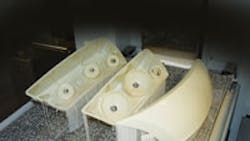Like a fingerprint, an individual's ear canal is entirely unique in size and shape. For this reason, the fitting of a hearing aid has to be customized and shaped to precision. For years, this was a highly inexact science and extraordinarily time-consuming.
But that's not the case anymore. Today, the contours of a patient's ear can be digitized in CAD/CAM software within minutes. In just a few hours, a custom-fitted hearing aid shell can then be created from liquid photopolymer. All this is made possible by advances in rapid prototyping.
As a technology, rapid prototyping has been around for 25 years. Initially, it served as a breakthrough to speed up product development, allowing engineers to see and hold a physical representation of a design. What's changed is that engineers aren't the only ones using rapid prototyping. Nor is it limited to just prototypes.
A prototype of automotive car headlights produced from 3D Systems' Accura 25 Plastic is ready for functional testing.
"You're seeing it in the production of hearing aids because the technology offers a freedom of creation," says Reichental. "Its ability to accommodate biomechanical materials makes it uniquely suited for hearing aid devices. You're also seeing its use in dental applications for crowns and bridges."
Rapid prototyping can help manufacturers produce several thousand parts at a time in short turnaround, bridging the gap between when a part design is finished and when it goes into production.
Perhaps the most significant advantage of rapid prototyping evolving into rapid manufacturing is that it can help bridge the gap between when a part design is finished and when the part goes into production. If, for example, a company needs several thousand parts molded while waiting for tooling to be made, production parts can be rapidly manufactured to jump-start the process.
Both rapid prototyping and manufacturing use additive manufacturing, a process of creating a physical object through selective fusion, sintering, or polymerization of a material. A design is created using a CAD program which controls the building of a part layer by layer with powdered material.
For the most part, rapid prototyping uses a variety of thermoplastics to produce a piece. But already a wider range of materials are being used, from aluminum to various super alloys such as nickel-based chromium and Cobaltchrome.
"The industry doesn't have a catalogue of 20,000 materials available today," says Paul Blake, vice president of research and development at Stratasys Inc., a provider of 3-D printer and production systems. "Right now, I'd say it sits at about 50."
One of the chief features that separates the technology from other processes is that in rapid prototyping and additive manufacturing a part is grown. Unlike metal cutting, where excess material is removed until the final product is achieved, there is no scrap in additive manufacturing.
Rapid manufacturing has evolved into medical applications, such as the production of hip joints. Medical companies are able to produce patient-specific replacements using CT scan data.
It is for this reason that rapid prototyping and manufacturing is so unique. It doesn't require an operator standing over the machine at all times, nor does it need jigs or fixtures to create a part.
"All you have to do is load a file and you can replicate shapes that are not manufacturable through traditional methods," says 3D Systems' Reichental. "I call it a flexible factory in a box."
See Also
